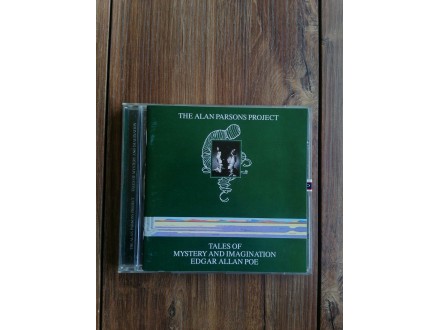The Alan Parsons Project - Tales Of Mystery And Imagina
| Cena: |
| Želi ovaj predmet: | 2 |
| Stanje: | Polovan bez oštećenja |
| Garancija: | Ne |
| Isporuka: | Pošta Post Express Lično preuzimanje |
| Plaćanje: | Tekući račun (pre slanja) Lično |
| Grad: |
Novi Sad, Novi Sad |
Izdavač: Ostalo
Žanr: Elektronska muzika, Rok
Poreklo: Strani izvođač
Made in Russia
Knjizica od 16 str.
Odlicno ocuvano
knjizica 5 Cd 5/5-
Tales of Mystery and Imagination (Edgar Allan Poe) is the debut studio album by British rock band The Alan Parsons Project. It was released on 25 June 1976 in the United Kingdom by Charisma Records. The lyrical and musical themes of the album, which are retellings of horror stories and poetry by Edgar Allan Poe, attracted a cult audience. The title of the album is taken from the title of a collection of Poe`s macabre stories of the same name.
Musicians featured on the album include vocalists Arthur Brown of The Crazy World of Arthur Brown on `The Tell Tale Heart`, John Miles on `The Cask of Amontillado` and `(The System of) Dr. Tarr and Professor Fether`, and Terry Sylvester of The Hollies on `To One in Paradise`. The complete line-up of bands Ambrosia and Pilot play on the record, along with keyboardist Francis Monkman of Curved Air and Sky.
Tales of Mystery and Imagination peaked at #38 on Billboard`s Pop Albums chart. The song `(The System Of) Doctor Tarr and Professor Fether` peaked at No. 37 on the Pop Singles chart, and No. 62 in Canada.[5]
Composition
`The Raven` features actor Leonard Whiting on lead vocals, with Alan Parsons performing vocals through an EMI vocoder. According to the album`s liner notes, `The Raven` was the first rock song to feature a digital vocoder. The prelude section of `The Fall of the House of Usher`, although uncredited, is taken verbatim from the opera fragment `La chute de la maison Usher` by Claude Debussy which was composed between 1908 and 1917.[6] `The Fall of the House of Usher` is an instrumental suite that runs more than 15 minutes and takes up most of Side 2 of the recording.
Artwork
The album`s cover art was made by Hipgnosis. Storm Thorgerson said that Eric Woolfson and Parsons wanted a `classy` design, including a book of lyrics, lengthy credits, and a chronology of Poe`s life. He described the recurring image of the `taped` man:[7]
Poe was preoccupied with entombment. Many of his characters have been incarcerated in some form or other – in coffins, brick walls, or under floorboards. We came up with the `taped` man – a mummy-like figure who is wrapped, not in bandages, but in 2` recording tape. This motif is partially horror-like, as well as being `entombed`, and the 2` tape appropriately suggests that the album is done by a producer in a studio, as opposed to a band recording material they will play on stage. Although the clients were intrigued by this idea they did not desire a pictorial cover but preferred instead a precise graphic representation. The narrow strip of illustration from George [Hardie] shows a long shadow of the taped man.
The booklet (attached to the inside of the cover) is composed of photos related to the songs, and line drawings that explore the taped man as he thrashes about in his restricted world and strives to unravel himself. The illustrated capital letters continue the idea. The layout and drawings are by Colin Elgie. The sleeve is one of our better attempts at combining photographs and illustration.
Reissues
Originally simply called The Alan Parsons Project, the album was successful enough to achieve gold status. The identity of The Alan Parsons Project as a group was cemented on the second album, I Robot, in 1977.
In 1987, Parsons completely remixed the album, including additional keyboard and guitar passages and narration (by Orson Welles) as well as updating the production style to include heavy reverb and the gated reverb snare drum sound, which was popular in the 1980s. He also made the end of side A segue into the start of side B due to the remix of the album being released when CD`s were commercially available, thus no need to stop playback to change sides. The CD notes that Welles never met Parsons or Eric Woolfson, but sent a tape to them of the performance shortly after the album was manufactured in 1976.
The first passage narrated by Welles on the 1987 remix (which comes before the first track, `A Dream Within a Dream`) is sourced from an obscure nonfiction piece by Poe – No XVI of his Marginalia (from 1845 to 1849 Edgar Allan Poe titled some of his reflections and fragmentary material `Marginalia.`) The second passage Welles reads (which comes before `The Fall of the House of Usher` (Prelude), seems to be a partial paraphrase or composite from nonfiction by Poe, chiefly from a collection of poems titled `Poems of Youth` by Poe (contained in `Introduction to Poems – 1831` in a section titled `Letter to Mr. B-----------`; the `Shadows of shadows passing` part of the quote comes from the Marginalia.
In 1994, Mobile Fidelity Sound Lab (MFSL) released the original 1976 version on CD (UDCD-606), making the original available digitally for the first time.
In 2007, a Deluxe Edition released by Universal Music included both the 1976 and the 1987 versions remastered by Alan Parsons during 2006 with eight additional bonus tracks.
In 2016, a 40th Anniversary Edition 3CD/1BD was released, featuring both 2007 Deluxe Edition CDs, a third disc with demos, outtakes, and other tracks, and a Blu-ray featuring a 5.1 surround sound version of the album remixed by Alan Parsons in 2016.
Covers
A variant of the song `The Raven` appears on the Eric Woolfson album Edgar Allan Poe (2009), which contains the complete music from Woolfson`s 2003 stage musical of the same name. The variant track does not appear on Woolfson`s 2003 CD Poe: More Tales of Mystery and Imagination, which was a highly abridged version of the stage musical. On the variant, the bass line and keyboard chords of the original Tales of Mystery and Imagination track are heard, but they are quieter, do not feature a vocoder, and instead of an abridged version of the Poe poem being sung, the Woolfson version features a fuller spoken dramatic reading of the poem. The Alan Parsons album A Valid Path includes `A Recurring Dream Within a Dream`, a composite of `A Dream Within a Dream` and `The Raven` incorporating electronic music influences.
Slough Feg covered `The Tell-Tale Heart` for their 2010 album The Animal Spirits.
Track listing
All tracks are written by Eric Woolfson and Alan Parsons except `The Fall of the House of Usher` by Woolfson, Parsons, and Andrew Powell. Timings from 1987 remix.
Side one
No. Title Lead vocals Length
1. `A Dream Within a Dream` Instrumental 3:42
2. `The Raven` Alan Parsons, Leonard Whiting 3:57
3. `The Tell-Tale Heart` Arthur Brown (additional vocals: Jack Harris) 4:38
4. `The Cask of Amontillado` John Miles (additional vocals: Terry Sylvester) 4:33
5. `(The System of) Dr. Tarr and Professor Fether` John Miles (additional vocals: Jack Harris) 4:12
Side two
No. Title Lead vocals Length
1. `The Fall of the House of Usher`
`Prelude` – 7:02
`Arrival` – 2:39
`Intermezzo` – 1:00
`Pavane` – 4:36
`Fall` – 0:51`
Instrumental 15:13
2. `To One in Paradise` Terry Sylvester (additional vocals: Eric Woolfson, Alan Parsons) 4:21
Orson Welles` narration does not appear on the original 1976 mix of the album. It does, however, on the 1987 remix: specifically on `A Dream Within a Dream`, and on the extended Prelude of `The Fall of the House of Usher`.
Personnel
Track numbers in parenthesis.[13][14]
Alan Parsons – EMI vocoder (2), Projectron synthesizer (3, 7, 10), recorder (5), additional vocals (11), synthesizer (3-4 on 1987 remix), cathedral organ (5 on 1987 remix) producer, engineer
Eric Woolfson – keyboards (1-3, 5, 7), backing vocals (2, 4), harpsichord (4), organ (7), additional vocals (11), synthesizer (9 on 1987 remix) executive producer
Andrew Powell – orchestral arrangement (2-4, 6, 8, 10), orchestral conductor (2-4, 6, 8, 10), keyboards (7), organ (9)
Francis Monkman – organ (7), harpsichord (9)
Billy Lyall – keyboards (1, 3), recorder (1), piano (4-5), Fender Rhodes electric piano (11), glockenspiel (11)
Christopher North – keyboards (2)
Orson Welles – narration (1 and 6 on 1987 remix)
Leonard Whiting – lead vocals (2), narration (11, 1 on 2006 remaster)
Arthur Brown – lead vocals (3)
John Miles – lead vocals (4-5), electric guitar (5)
Jack Harris – additional vocals (3, 5)
Terry Sylvester – additional vocals (4), lead vocals (11)
Jane Powell – backing vocals (11)
Smokey Parsons – vocals
Bob Howes & the English Chorale – choir (2-4)
Westminster City School Boys Choir – choir (11)
David Paton – acoustic guitar (1, 11), backing vocals (1), bass guitar (3-5, 7, 11)
Kevin Peek – acoustic guitar (9)
Laurence Juber – acoustic guitar (9)
Ian Bairnson – electric guitar (1, 3-5, 7, 11, 2 on 1987 remix), acoustic guitar (1, 11)
David Pack – electric guitar (2)
Joe Puerta – bass guitar (1-2)
Les Hurdle – bass guitar (6)
Daryl Runswick – double bass (9)
David Katz – violin, orchestra leader (6, 8, 10), orchestra contractor
Jack Rothstein – orchestra leader (6, 8, 10)
David Snell – harp (9)
Hugo D`Alton – mandolin (9)
Stuart Tosh – drums (1-5, 7, 9, 11), timpani (3), backwards cymbals (3)
Burleigh Drummond – drums (2)
John Leach – cimbalom (9), kantele (9)
Dennis Clarke - saxophone, clarinet
Production staff
Gordon Parry – engineer
Tony Richards – assistant engineer
Chris Blair – assistant engineer
Tom Trefethen – assistant engineer
Pat Stapley – assistant engineer
Peter Christopherson – photography
Aubrey Powell – photography
Storm Thorgerson – photography
Sam Emerson – photography
Hipgnosis – design, cover art
Colin Elgie – artwork, graphic design, layout design
Studio album by The Alan Parsons Project
Released 25 June 1976[1]
Recorded July 1975 – January 1976
Studio
Abbey Road, London
Mama Jo`s, Hollywood, CA
Kingsway Hall, London
Genre
Progressive rockart rocksymphonic rock
Length 42:38
Label
Charisma20th Century Fox
Producer Alan Parsons
The Alan Parsons Project chronology
Tales of Mystery and Imagination
(1976) I Robot
(1977)
Predmet šaljem nakon uplate na moj tekući račun ili po dogovoru.
Lično preuzimanje je uvek moguce u Novom Sadu po dogovoru,ili na mojoj adresi .
Molim kupce da pre licitacije pitaju sve sto ih zanima, kako bi izbegli eventualne nesporazume.
U slučaju bilo kakvog problema nakon preuzimanja paketa, kontaktirajte me pre davanja ocene kako bi isti pokusali da rešimo.
Ne šaljem pouzećem.
Za prodaju cd-ova : Plastične kutije su zamenjive i njih NE OCENJUJEM! Takodje zadnja strana iza plastike drzaca cd je vidljiva slika, za njih isto ne ide ocena, sve se vidi!
Predmet: 75355729











